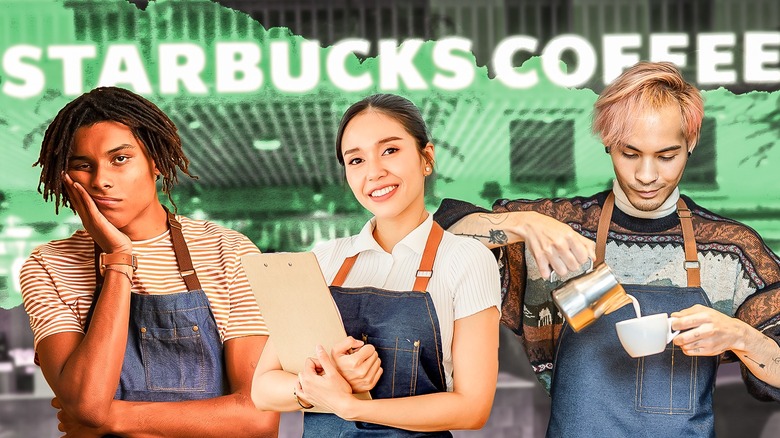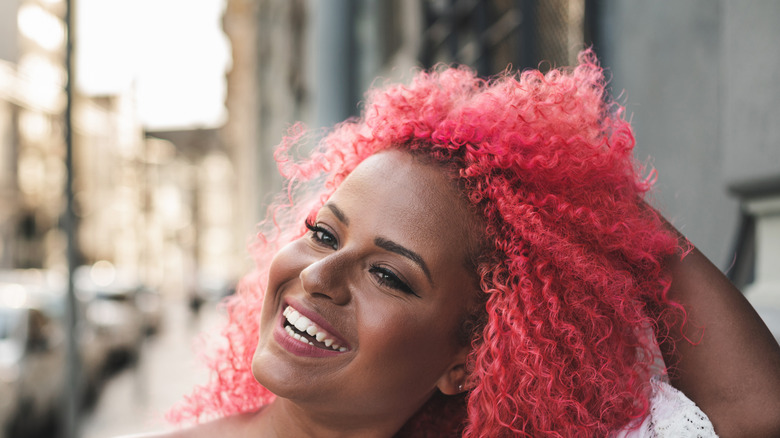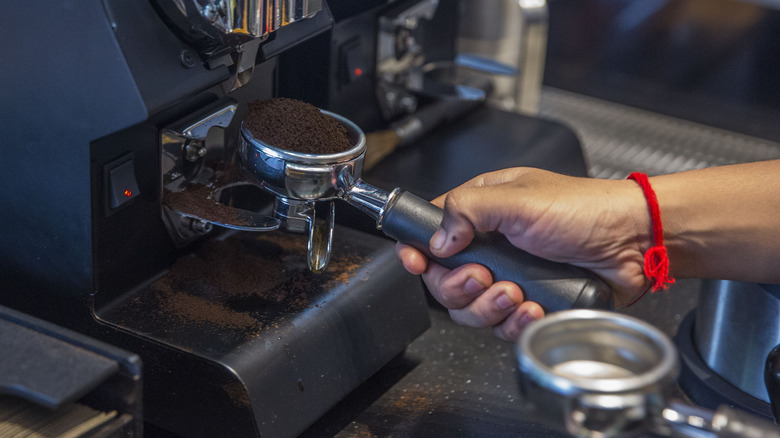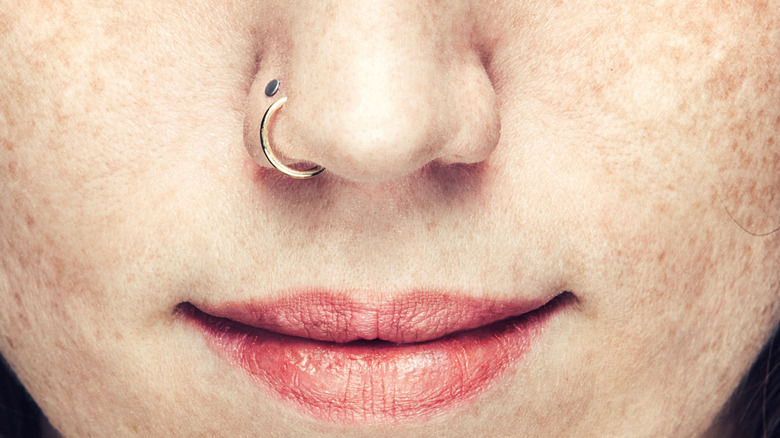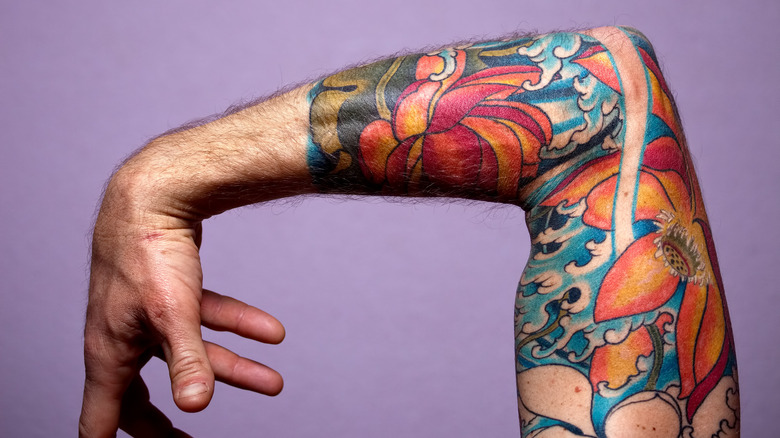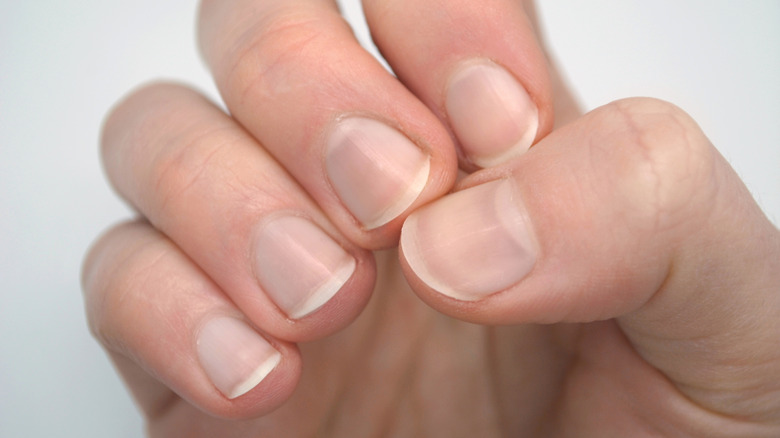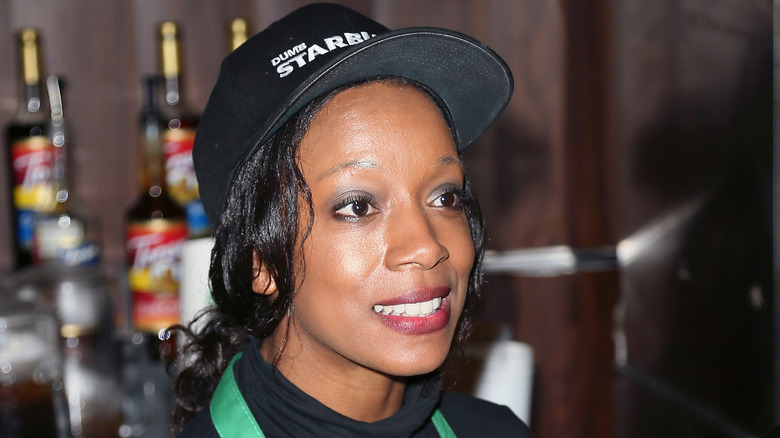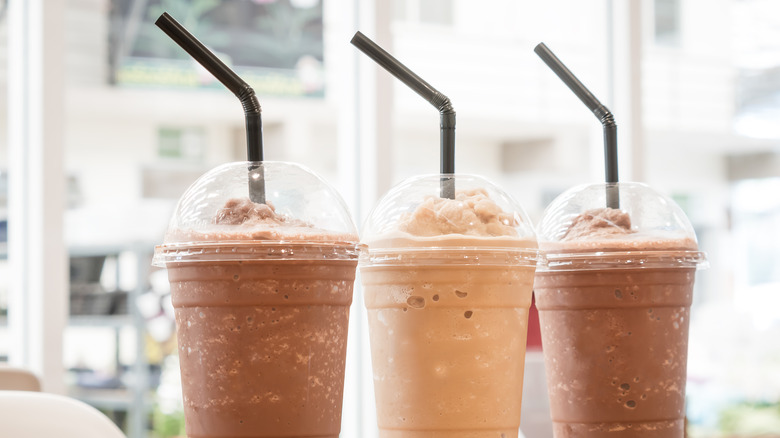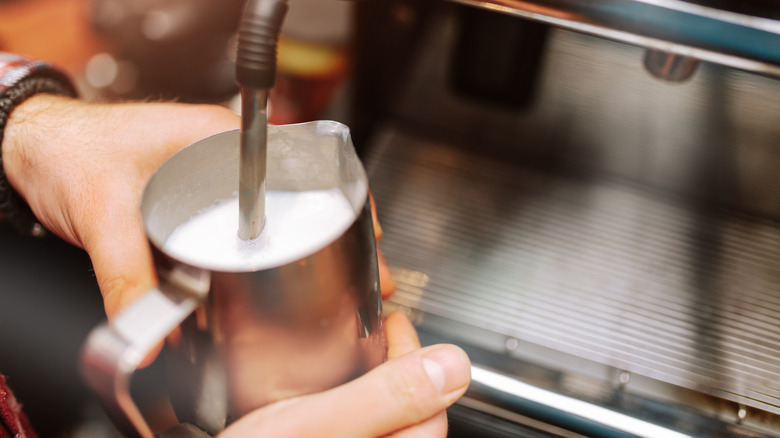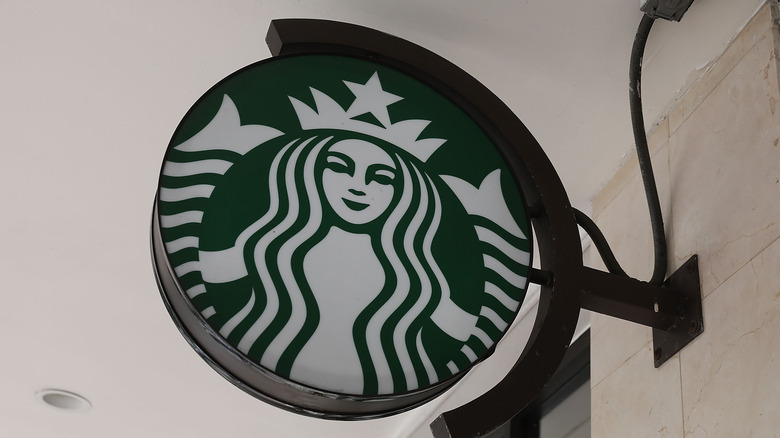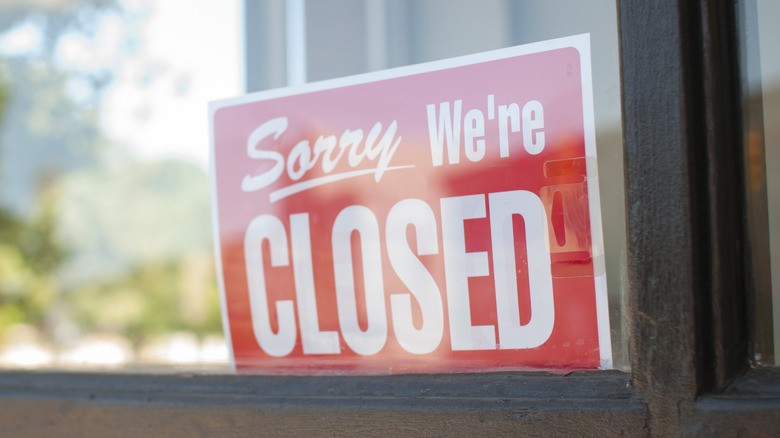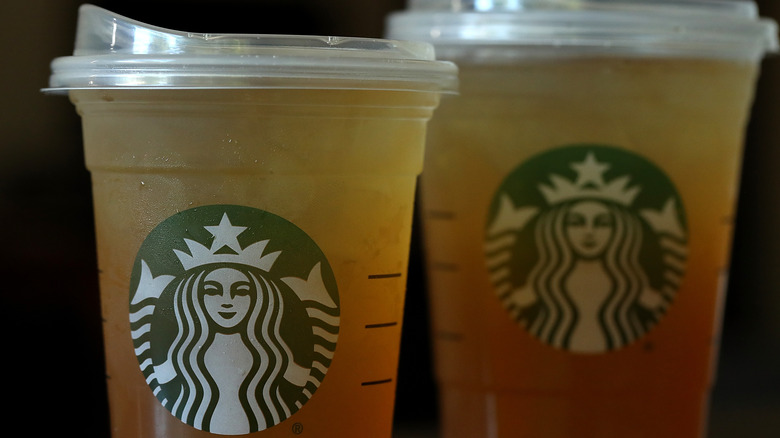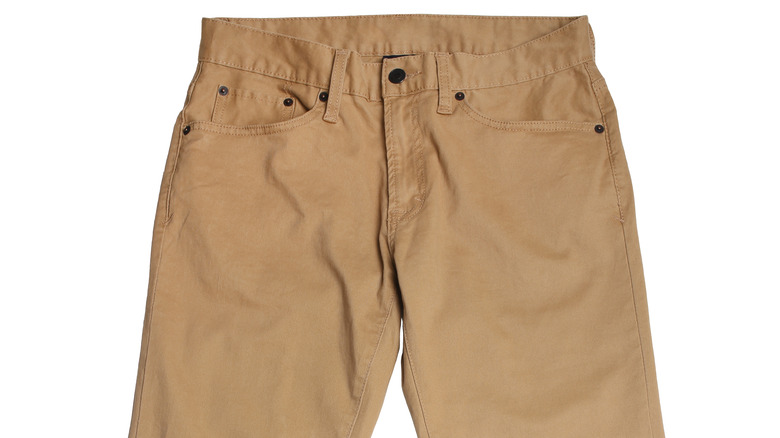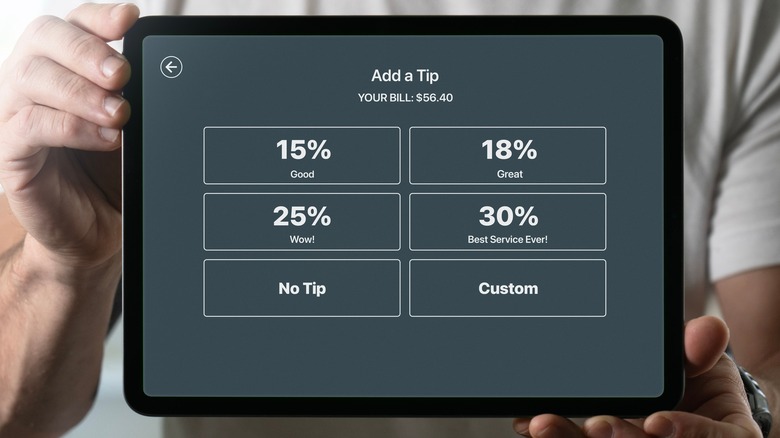14 Rules You Didn't Know Starbucks Employees Had To Follow
Love the company or hate it, Starbucks has a firm foothold in the United States. According to Statista, Starbucks directly operated 9,265 stores and licensed another 6,608 in 2022. This astounding number of outlets made Starbucks the largest coffee shop chain in the country that year.
Consistency is key when operating multiple units in 52 U.S. states and territories, let alone the other 79 countries where it maintains outlets. Walking into any Starbucks store, you'll see a marked uniformity with every other outlet you've been in. No matter your location, you'll rarely doubt you're in a Starbucks, from the "look and feel" to the beverages. That uniformity is vital for visual branding, but it also ensures your food or drink experience will be nearly identical in every store.
There are processes and rules in place that every employee must follow to ensure uniformity of the customer experience. Drink-making follows precise, step-by-step standard procedures with no deviation allowed. Dress codes and clothing colors follow a strict guide. Rumored but unproven is that employees must always display a sunny demeanor and smile.
Some of the rules and processes simply follow proper sanitation guidelines. Others are the byproduct of a colossal legal blunder. Others, while they may restrict individuality, keep the brand on point. We've researched policies, consulted the official dress code, and spoken with employees to compile this, at times surprising, list of rules that Starbucks employees must follow.
1. Commit to a hair color
As this LinkedIn post shows, Starbucks encourages employees to bring their authentic selves to work. The company doesn't frown on colored hair, but it does insist that dyes be permanent or semi-permanent. While that may seem a strange mandate, it doesn't have anything to do with preference or style. In fact, it's actually rooted in food safety.
Temporary hair color typically washes out in one shampoo, whereas semi-permanent, demi-permanent, and permanent last at least 12 washes, per Matrix. Temporary color can run and splotch, getting on anything it touches, including hands and cups, which isn't a great garnish for your chai latte at the drive-through. It's also rumored that temporary hair color can increase instances of hair falling out. Likewise, glitter is a no-no for the same reason. While this rule seems restrictive on the outside, it's an abstract food safety precaution that makes sense.
2. Employees cannot move to a different station
Division of labor is one of the basic principles of production. This concept allocates a worker, or group of workers, to focus on a single task or area of tasks. Each Starbucks employee gets assigned to a specific station for their shift and handles the tasks assigned to that station to maximize throughout.
If a worker at one station finds themselves not busy during a high business point of the shift while another station struggles, the non-busy worker cannot take it upon themselves to help the more impacted station. Supervisors may redirect an employee to assist another station or reassign workers to cover breaks, but workers cannot make those calls.
One can argue that a policy like this strips workers of simple decision-making processes, but the rule stands. There can be several rationalizations for this, such as the employee may not be aware of the entirety of business levels and accidentally throw a well-intentioned wrench into the corporate-designed efficiency of operations. A well-meaning employee could also be untrained or undertrained on the station they're trying to help, causing mistakes and slowing the overall throughout of orders.
3. Piercings are limited
Policies formerly stated that, despite the "bring your authentic selves to work" statement, facial piercings were a hard no from a corporate standpoint. Ear gauges or plugs were also in the "no" category. The latest version of Starbucks' dress code shows that policy has relaxed a bit, possibly due to constraints that policy placed on the available labor pool.
An infographic from Inksane Piercing shows its largest customer demographic (about 46%) is between the ages of 18 and 29. Not uncoincidentally, 61% of Starbucks employees are between 20 and 30 years of age. Whether that information influenced the policy or not, it seems that Starbucks is attempting to strike a balance between its brand image and evolving societal norms. The dress code now allows employees to have one facial piercing, but it must be smaller than a dime. Ear gauges (stretched earlobe piercings) are likewise allowed, but only if the hole is smaller than a quarter.
4. Tattoos are subjective
The tattooed, mustachioed, surly barista trope is one that Starbucks eschewed for its employees. For a company that started in the grunge capital of Seattle and saw exponential growth during the Gen X-dominated 1990s, Starbucks kept a more wholesome image for its employees by not allowing them to display their tattoos. That is, they couldn't until 2014 when employees petitioned for and won the right to have visible tattoos. According to CNN, the policy change came alongside unspecified pay raises and a worker shift snack.
The current dress code allows visible tattoos, albeit with some caveats. Many — arguably most — visible tattoos are fine, but those deemed inappropriate, including anything obscene or sexual, are not permitted and require employees to cover them up. Tattoos on the neck and face are also exempt from the policy. The policy also excludes tattoos deemed racist or profane from public display in Starbucks' stores.
5. Keep things plain
The Starbucks dress code dictates what employees may do with their hands. Much of this policy ensures compliance with the U.S. Food and Drug Administration's (FDA) Food Code.
For example, employees may not wear rings, with the exception of one plain band, while on shift. Rings notoriously trap bacteria in trace amounts of food or beverages that can get trapped in more ornate designs, so the FDA and Starbucks prohibit them. The policy bans wristwatches for the same reason. The Food Code establishes the minimum standards for food safety and calls for people with nail polish or fake fingernails to cover their hands with gloves to minimize the chances of chips, flakes, or whole fingernails from getting into customers' food. Starbucks says no to all of the above as an extra precaution.
In a less health-risk-oriented standard, Starbucks' dress code also says "no" to perfume, cologne, or grooming products with fragrances. Restrictions on scents are long-standing industry standards, and some restaurants ban customers from wearing strong fragrances. Keeping the air clean for customers with strong reactions to perfumes and not masking the coffee's aroma are the driving factors behind this set of rules.
6. They can't ask you to leave
A Starbucks employee cannot ask you to leave the premises, even if you sit in their stores without ordering anything. According to National Public Radio, in 2018, Starbucks employees at a Philadelphia, Pennsylvania, store asked two men who hadn't ordered anything to leave. The two were waiting for a third person to join them for a meeting. The situation escalated quickly, the police got involved, and the two men were arrested after again refusing to leave the premises. A lawsuit ensued, ending in a quick out-of-court settlement.
In the aftermath of this scenario, Starbucks changed its employee policy when dealing with such situations. Customers can now sit in the cafe without ordering for as long as they like, provided they're not creating a health or safety issue for themselves, other customers, or employees. The employee may not ask the customer to leave even if they are making a scene. They must call the police to remove a person rather than act on the situation themselves.
7. They can only work on three drinks at a time
Even during the busiest times of the day, Starbucks employees have restrictions on how many drinks they can work on simultaneously. Older policies limited baristas to working on two drinks at a time, and the first drink had to be substantially completed before starting the second.
A current Starbucks employee confirmed they may now work on three drinks at a time, but it's complicated. If a barista is making a frappuccino and receives an order for a second drink, they may start making that drink. If they get an order for a flat white while working on the other two drinks, they can begin to prepare it, provided they are in the final step of the frappuccino – snapping the lid on the drink. Presumably, this policy ensures a barista doesn't get overwhelmed and forget the multi-step process of each beverage, which is another step towards consistency across the entire company.
8. Every drink's milk gets steamed separately
McDonald's founder Ray Kroc established three brand promises when building the fast food restaurant into an empire: consistency, cleanliness, and convenience. Consistency has been a yardstick for multiple chains' expansions ever since. For Starbucks, a drink purchased in San Francisco must be identical to one purchased in Edinburgh, and they've developed processes for each drink. A barista must memorize the steps and amounts of ingredients for each drink before they're allowed to make them, following those exact procedures.
A barista's life would be much easier if they were allowed to make multiples of the same drink, say, three lattes, at once. However, to avoid straying from the procedure and potentially affecting the consistency of the beverage, the barista must steam the milk for each latte individually. Although it increases the workload and diminishes efficiency, Starbucks sees it as a worthwhile tradeoff for brand consistency.
9. You can use the restroom
Most of us have been there — in need of a public restroom and not wanting to purchase something from the proprietor for whatever reason. Welcome to Starbucks! You're allowed to use their restrooms; no purchase is required. As a byproduct of the same lawsuit that resulted in employees not being allowed to ask people to leave, they also can't restrict you from using their restrooms. Even if an outlet keeps the restroom doors locked, the policy requires the employees to provide you with a key or code upon request.
This "open door" policy, so to speak, isn't without some repercussions. A 2019 joint business study showed an almost 7% decline in walk-in business after the policy went into effect. The decline was 84% higher in stores near homeless shelters. Also, customers cut their average stay time by about 4%. But that decline must balance out to be less than the cost of a lawsuit for denying a customer the opportunity to use the restroom.
10. Operating hours are strictly enforced
For those who've never worked in the food service industry, slipping into a restaurant a few minutes before they open seems like no big deal. "I'll just sit here quietly and wait," you say. Even if you don't interrupt employees by asking questions or requesting, "Just a glass of water while I wait," it interrupts the opening procedural flow. You could be standing in a seemingly out-of-the-way spot and unknowingly be smack in the middle of where the employee needs to be working.
Starbucks strictly enforces its opening and closing times. No customers are allowed inside until the exact opening time, and customers are politely shown the door at closing time. Yes, this seems extreme, but aside from efficiency issues in opening or closing the store, there are also safety considerations. Customers locked in with employees may have the best intentions in the world, but a small percentage don't, and keeping employees safe is a strong factor in this policy.
11. Cold drinks get a minimum number of shakes
Some folks never think twice about their bartender shaking their drinks before pouring them. Others ask questions, and they'll find that how the bartender shakes a drink affects the mixing of ingredients, their chilling, and the dilution of certain ingredients.
So, too, does the shaking of non-alcoholic beverages affect their overall taste and presentation. When mixing hot ingredients, they need to cool quickly before the ice dilutes them too much. Syrups, which normally incorporate well in hot drinks, don't distribute well in cold temperatures, so a good shake helps disperse them more evenly. There's also a bit of foam that develops from the shaking, which adds to the textural and visual experience.
In its quest to maintain consistency across its brand, regardless of location, Starbucks has procedures for every drink. When it comes to Starbucks' cold teas and refreshers, each drink must receive a minimum of 10 shakes before it reaches the customers' hands. Although sources state otherwise, an employee confirmed this policy doesn't apply to iced coffee, cold brew, or iced lattes.
12. They can't say no to a customer
In an environment based on people pleasing, "no" is a hard word to use. As such, employees cannot say no to a customer in almost all cases. There are exceptions to this policy, like not allowing customers to be inside the store during non-operating hours, a request that could cause harm, or in the case of food allergies.
The result of this policy can be a giant game of "Yes, And," especially when dealing with complicated orders or accommodating Starbucks' secret menu. A customer could ask for an extra shot after paying, and it's expected that the employee says yes. If a customer asks to warm their coffee in the microwave, the employee can steer them in a direction that works in their favor instead of saying no. "I'd be happy to warm that with a bit of steamed milk," is a common reply. It's not exactly a "no," but it works as one while the employee says yes.
13. White shoes are fine, but don't wear white pants
It was once policy that employees wore specific colors, mostly earth tones, and loud, vibrant colors were prohibited from the workplace. White shoes were once a no-no. The current dress code dictates what an employee should look like but has relaxed from the strictness some sources have reported.
Some policies, like head coverings, hair, and facial hair restrictions, directly reflect health codes. Others are more "look and feel" oriented. Employees are no longer restricted to earth-toned tops, but shirts should be in solid colors or free of loud patterns. Shoes must follow health and safety regulations, but white is no longer a prohibited color. Pants or other bottoms, however, have restrictions on them. Black, brown, navy, khaki, and brown are all within the acceptable color palette, but white is off-limits. You might notice that most of the color palette is good for hiding coffee stains, which white definitely does not, and that may be a large guiding factor in this decision.
14. Tips must be split
When ordering food or a drink at Starbucks, you typically act indirectly with at least two people. There's the obvious person who takes your order; then there may be another person who handles your food while another makes your drinks. So it shouldn't be surprising that the tip you leave is distributed amongst them. But that tip isn't limited to the people you've interacted with.
It's been a long-standing practice that Starbucks employees split tips evenly based on the total tips for the week and how many hours an employee worked. This practice was challenged in two separate court filings in 2008, which sought to exclude shift supervisors and assistant store managers from participating in the tip pool. An appeals court later confirmed supervisors and managers were exempt from tip shares. At the time, laws varied from state to state, but the U.S. Department of Labor finalized rules surrounding pooled tips in 2021, in line with the appeals court, meaning supervisors and managers weren't allowed to participate. All of this is a very long way to explain that no matter how good the service is, the person you're tipping will only receive a percentage of that tip. So, by all means, please tip and tip well, but just remember that the person you're tipping will have to share that tip with the other employees.
